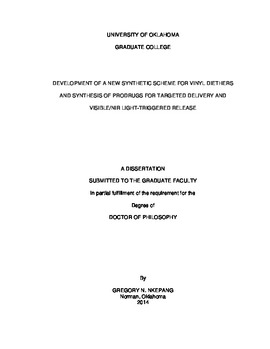| dc.description.abstract | Tumor specific drug delivery has become increasingly interesting in cancer therapy, as the use of chemotherapeutics is often limited due to severe side effects. Targeted chemotherapy for cancer treatment offers a great potential advantage in tumor treatment due to greater specificity of delivery, which leads to an increased dose of the cytotoxin delivered to the malignant cells relative to healthy cells in the rest of the body. There are two general directions in anticancer drug delivery that focus on achieving a high local drug concentration specifically in the cancerous tissue while reducing its uptake in healthy cells. i) Site-specific delivery can be achieved by conjugating the drug or coating the delivery vehicle (liposomes, micelles, etc.) with ligands or antibodies that target overexpressed receptors in the tumor tissue. This could also possibly be used to direct a drug away from the body sites that are sensitive to the toxic action of the carried drug (site avoidance). ii) By incorporating an active and site-specific release mechanism within the prodrug or delivery vehicle, it is possible to increase the release and therapeutic efficacy of the cytotoxic agent. A chemotherapeutic drug delivery system designed to combine these two principles (site–specific targeting and site-specific triggering) will fulfill Paul Ehrich’s vision of a magic bullet in the treatment of diseases there by overcoming the selectivity problems of conventional chemotherapy.
The folate receptor (FR) is a potentially useful biological target for the management of human cancers. Owing to the overexpression of the FRs on the surface of malignant cells, conjugation of the cytotoxic agent to folic acid (FA) via suitable spacers has demonstrated the enhanced selective drug delivery to the tumor site. Furthermore the degree of over-expression has been found to correlate with the stage of tumor growth. Various FA-conjugated prodrugs and folate targeted delivery vehicles have been synthesized and are currently in preclinical and clinical trials. Biotin (vitamin B7) is also an essential cellular micronutrient responsible for various normal cellular functions, and its receptors are overexpressed in various cancer cell lines. It has been suggested that the sodium dependent multivitamin transporter (SMVT) is responsible for the uptake of biotin. It has also been indicated that there has been a higher expression of SMVT in several lung, renal, colon and breast cancer cell lines than FR. Several biotinylated anticancer agents have also been used in the selective delivery to cell lines overexpressing the SMVTs. Most of the folate and biotinylated conjugates are equipped with release mechanisms that rely on intrinsic activating agents such as small changes in temperature, pH differences, enzyme and an external activating tool such as light triggered release (light of shorter wavelengths). The use of light of longer wavelengths with better tissue penetration to active release of the drugs is warranted, which then will lead to the search for novel singlet oxygen photocleavable linkers.
To address this issue, our lab has screened various olefins and identified vinyl diether linker as a potential singlet oxygen-mediated photocleavable linker that can be cleaved with a fast rate and in the presence of a photosensitizer (core-modified porphyrin). The reported synthetic schemes were for symmetric molecules with lengthy reaction steps and some reaction conditions not being functional group tolerant. Herein, the chemical synthesis (synthetic scheme) and kinetic studies of vinyl diether and some nitrogen and sulphur analogs will be described. The potential application of the vinyl diether linker to the synthesis of the biological active molecule was not achieved due to high instability of the linker in the presence of light. Hence we turned our attention to the alternative linker, the aminoacrylate linker, which could be synthesized with high yields and was functional group tolerant.
A multifunctional drug delivery system constituted of the folate (or biotin) linked to the photosensitizer (phthalocyanine) by PEG and combretastatin A-4 linked to the photosensitizer by a photolabile linker (aminoacrylate) was designed and synthesized, and biological activity of six conjugates were determined. The conjugates were prepared through straightforward and versatile synthetic routes. The evaluation of cell specificity was examined using colon 26 cells that overexpress both the folate receptors and biotin receptors. Three of the conjugates (FA-PEG2K-PC-CA4, Biotin-PEG897-PC-CA4 and FA-PEG897-PC-CA4) exhibited high specificity in the in vitro test conducted and in vivo imaging using the colon 26 cells. Preliminary in vivo PDT indicated tumor shrinkage after the irradiation with two of these conjugates: FA-PEG2K-PC-CA4 and Biotin-PEG897-PC-CA4. (Data not included in the thesis)
The ability of the multifunctional prodrugs of optical imaging and treatment by a combination of PDT and local chemotherapy could possibly lay the foundations for further development for the clinical management of FR and biotin receptor overexpressing tumors. | en_US |
